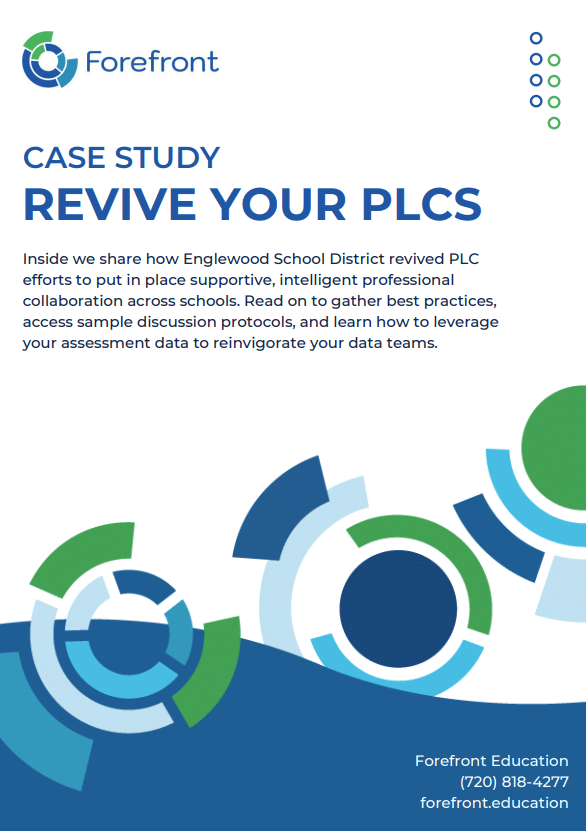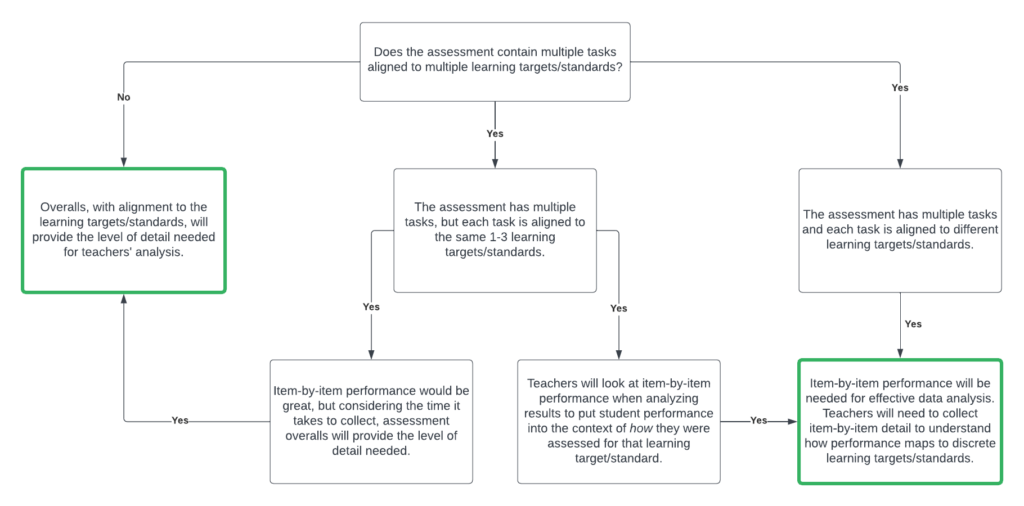Data for Teacher Learning
- December 14, 2023
- Blog

For many teachers, data is considered a four-letter word. For these teachers, data may carry a negative connotation. They may even vocalize the sentiment that they are “not a data person.” Often, what they are conveying is that the data they have access to is not useful to their work or proves challenging to interpret. They may lack the time to build data visualizations or invest in complex data software systems. However, recognizing the significance of data to teacher learning is key to school improvement.
Regardless of whether your district has implemented data driven instruction (DDI) practices, teachers spend time every week assessing student learning, analyzing assessment data, and targeting instruction. To make sure that your data serves teachers, it needs to be valuable to their work — related to classroom instruction — and accessible. The following 3 tips will ensure data supports teachers and improves instruction.
Consider What to Collect
If your district’s data systems do not include classroom assessment results, then they are not serving your teachers. Classroom assessments range from the purely formative to summative assessments used for grading and reporting. They are the richest information source for teachers. They let teachers know how students are responding to instruction, identify areas and students that need targeted support, and highlight students ready for enrichment and extension.
Nonetheless, although this information is valuable, gathering all classroom assessment data is not manageable. Consider which assessments are purely formative. These ungraded assessments provide powerful resources for feedback without judgment and offer information for teachers to adjust instruction, but do not need to be collected systematically.
Now consider which assessments also provide summative information. These are generally the same assessments used for grading. At their purest form, grades are a form of reporting student performance on grade-level expectations to students and parents. When collected systematically and well, these unit, module, and cumulative tests provide valuable information to teachers and grade-level teams. They communicate conceptual misunderstandings, additional supports needed, and students that are ready to go beyond and deeper into grade-level expectations.
Item-Analysis vs Overall
Once your district has identified the summative assessments that will provide valuable information to teachers, consider the required level of detail in the collected data. In technical data terms, this is referred to granularity, and means the level of detail present in your data structure. In assessment data terms, it could refer to collecting assessment overall scores (e.g. 38/40), item-level detail, or scores from the standards or learning targets assessed. When considering the level of detail that teachers need, in general, they need very detailed, granular information to inform instruction. This can become unmanageable if there are many summative assessment opportunities and teachers must collect item-by-item detail. The best guidance is to consider the following decision tree:
Once you have selected the data to gather and the level of detail needed, it is essential to consider how your data will be accessed.
Consider Accessibility and Ease of Interpretation
So many of the districts we support have done much of the important work of selecting the data they wish to collect for teachers. Many begin by using spreadsheets. Spreadsheet programs like Excel are extremely versatile and powerful, but there are limitations to spreadsheet programs:
Versatility
Versatility is both a strength and a limitation. It can be difficult to maintain consistency across classrooms using individual spreadsheets. District leadership must provide templates that are consistent across classrooms, lock cells, and understand that the integrity of the data can easily be compromised by human error in data collection.
Role-based Access
Role-based access presents an obstacle with spreadsheets. It requires district teams to create pivot tables that aggregate results for building and district grade-level performance. Providing access to classroom level spreadsheet data to entire teams of teachers exposes highly sensitive information.
Interpreting results
Sense making can be challenging. Data visualization programs, such as our solution Forefront, make it easy to visualize results in a variety of ways at the click of a button. Spreadsheets have a greater learning curve and necessitate an expertise that not all classroom teachers possess nor wish to acquire.
Teachers need flexibility so they can collect data in ways that are meaningful to them. Nonetheless, balance this need for flexibility with the need for consistent comparisons — apples to apples comparisons — in assessment results across classrooms. Consistent measures are in place when the same format for collecting summative assessment data across classrooms is in place. The same format refers to both the specific common assessment results collected, and the level of detail collected from these assessments. When collecting these measures consistently, teachers can access valuable insights that directly inform their work. At the same time, instructional leadership at both the building and district level can aggregate results. Leadership can then gain insights into student learning directly from classroom assessments.
Forefront offers role-based access to reports and visualizations. Role-based access maintains student privacy and provides teachers and leaders with a user experience personalized for how they wish to look at data. Unique in the space of education data software tools, we provide teachers with local norms to pull into class and student-level reports. Teachers can look at their students’ results in the context of grade-level performance at their school and district. This ability to view local norms improves professional collaboration with grade-level teams.
Build in Time for Data for Teacher Learning
This last recommendation is the shortest. It is also the most essential to your efforts in cultivating a data-driven culture among teachers. If it is important for your district to have teachers review assessment results and determine next steps, it is necessary to build in time for this collaborative work. Provide teachers with adequate time to connect with colleagues, discuss evidence of student learning, and plan responses.
Even with meaningful data that is easy to access and visually clear, teachers still need time to analyze results and plan next steps. This work is collective in nature, so providing teachers with time is essential to its success.
Want to learn more about our data solution? Connect with us for a quick demonstration of Forefront with the programs that you use.
About us and this blog
Our team and tools help schools implement standards-based grading, streamline assessment systems, and use meaningful data to drive decision-making.
Free PLC Case Study
Learn about how Forefront client Englewood School District put in place supportive, intelligent professional collaboration across schools. Download your free copy today to access best practices, view sample discussion protocols, and learn how to leverage your assessment data to reinvigorate your data teams.

More from our blog
See all postsForefront is the only assessment data solution optimized for classroom assessment results, leveraging these results to fuel instruction, PLCs, and grading. Elevate meaningful assessment data district-wide to transform how you understand and communicate about student learning across your schools.
Copyright © 2025 Forefront Education, Inc. All Rights Reserved.








